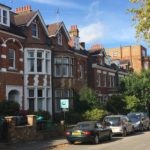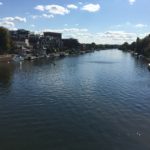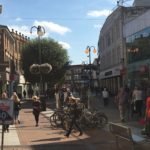 Just returned from a week in London, where our daughter will be attending university.
Just returned from a week in London, where our daughter will be attending university.
While the uncertainty over Brexit is causing some consternation in the UK, life in the Kingston-Upon-Thames section of London remains outwardly unaffected.
This was my second trip to London, and it was completely fascinating and enjoyable.
Five things I especially like about London:
- The design of the city is efficient and compact. Little or no space is wasted on huge, useless lawns and surface parking lots and population density is high, meaning offices, shops, cafes, and restaurants are almost always within walking distance. More people in less area means more opportunities for interaction, cooperation, economic activity, and creative collaboration – the building blocks of successful communities. The roads are not laid out in a grid, and they are not normally straight, so I am sure that driving is confusing, especially since the streets were not designed for cars and are narrow and often congested. But, as a tourist at least, there is no reason to drive a car in the city, as there is no place that you might want to go that you cannot easily reach on foot or by bus or train.
- Walking, biking, strolling, riding trains and riding buses are nearly always more convenient and enjoyable than similar activities in the USA. The non-auto transportation infrastructure is well-developed, well-designed, and well-maintained. The city was more than a thousand years old before cars were even invented, so you see virtually none of the auto-centric development that has defaced so much of America.
 The city is more crowded and diverse than I expected. Of the two, the crowds were more surprising. Shopping districts, museums, and parks all seem to be well-attended. At times, they are uncomfortably crowded. Not exactly sure why I didn’t expect the city to be crowded, as it was the most populous city on earth from 1831 until 1925. Today, it has more international arrivals each year than any other city. As for diversity, well, London was the center of a world-wide empire for hundreds of years, so it has always drawn migrants, immigrants, visitors, merchants, financiers, and government officials from all over the planet. While the empire is no more, London has remained one of the most accessible and open of the world’s great cities.
The city is more crowded and diverse than I expected. Of the two, the crowds were more surprising. Shopping districts, museums, and parks all seem to be well-attended. At times, they are uncomfortably crowded. Not exactly sure why I didn’t expect the city to be crowded, as it was the most populous city on earth from 1831 until 1925. Today, it has more international arrivals each year than any other city. As for diversity, well, London was the center of a world-wide empire for hundreds of years, so it has always drawn migrants, immigrants, visitors, merchants, financiers, and government officials from all over the planet. While the empire is no more, London has remained one of the most accessible and open of the world’s great cities.
- History is everywhere. The first settlement on the site was built by the Romans around 2,000 years ago. Ruins from the Roman era still can be seen. By 1300, London was a city of more than 100,000 inhabitants. Shakespeare’s theater, the Tower of London, the British Museum, Churchill’s war room and countless other sites remind us daily that we are links in an endless chain, and that we might be wise to consider the effect of our actions – or inactions – on future generations. Standing on a bridge that is 900 years old provides a perspective that is not easily available in the United States.
- The Royal Parks. Most cities have parks – but no place has a collection of enormous, accessible, well-maintained, and well-used parks like London. Hyde Park, Richmond Park, Green Park, Kensington Gardens and the other Royal Parks cover almost 5,000 acres of land in Greater London.
 “Aesthetically speaking, London is just beautiful; it’s a gorgeous city. The architecture, the monuments, the parks, the small streets – it’s an incredible place to be.” – Sara Bareilles
“Aesthetically speaking, London is just beautiful; it’s a gorgeous city. The architecture, the monuments, the parks, the small streets – it’s an incredible place to be.” – Sara Bareilles
“The vibe of London as a city is captivating. It’s both fast-paced and extremely rushed but still has the calmness that would attract any big-city person.” – Ali Fazal
Quotes from: https://www.brainyquote.com/topics/london
September 20, 2018
 The city is more crowded and diverse than I expected. Of the two, the crowds were more surprising. Shopping districts, museums, and parks all seem to be well-attended. At times, they are uncomfortably crowded. Not exactly sure why I didn’t expect the city to be crowded, as it was the most populous city on earth from 1831 until 1925. Today, it has more international arrivals each year than any other city. As for diversity, well, London was the center of a world-wide empire for hundreds of years, so it has always drawn migrants, immigrants, visitors, merchants, financiers, and government officials from all over the planet. While the empire is no more, London has remained one of the most accessible and open of the world’s great cities.
The city is more crowded and diverse than I expected. Of the two, the crowds were more surprising. Shopping districts, museums, and parks all seem to be well-attended. At times, they are uncomfortably crowded. Not exactly sure why I didn’t expect the city to be crowded, as it was the most populous city on earth from 1831 until 1925. Today, it has more international arrivals each year than any other city. As for diversity, well, London was the center of a world-wide empire for hundreds of years, so it has always drawn migrants, immigrants, visitors, merchants, financiers, and government officials from all over the planet. While the empire is no more, London has remained one of the most accessible and open of the world’s great cities.